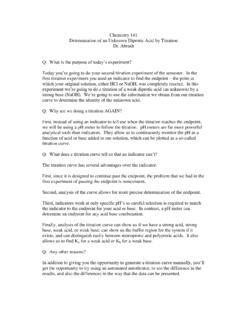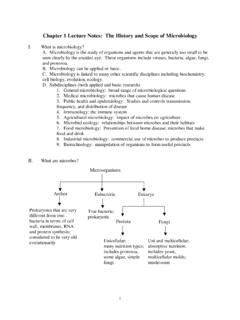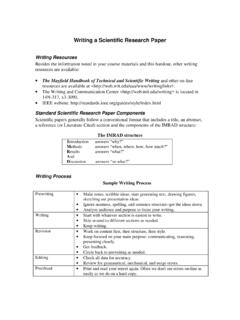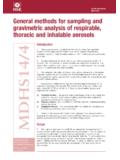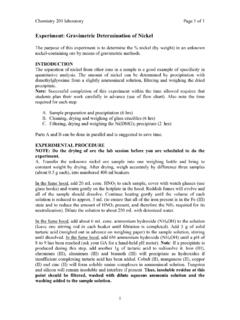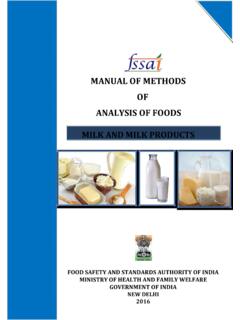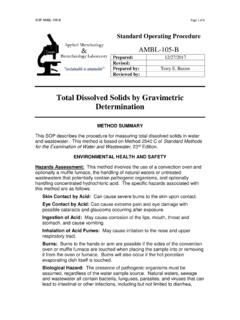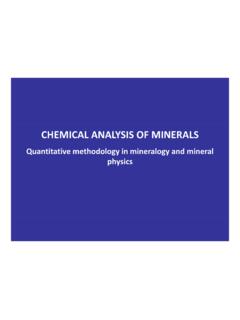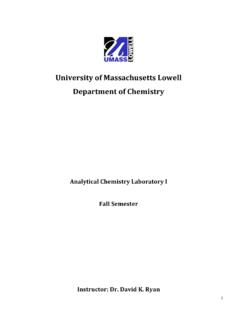Transcription of Classification of Analytical Techniques
1 Introduction to Instrumental AnalysisClassification of Analytical TechniquesIntroductionIn quantitative chemical analysis , a sample is prepared and then analyzed to determine theconcentration of one (or more) of its components. The following figure gives a general overviewof this or instrumentalsingle- or multi-channelrelative or absoluteFigure 1: Schematic showing measurement steps involved in quantitative chemical analysis of asample. There are three ways of classifying the process, based on the technique (classical vsinstrumental), the measurement data (single-channel vs multi-channel), or on whether additionaldata is needed to estimate the analyte concentration (relative vs absolute).There are a very large number of Techniques used in chemical analysis .
2 It can be very useful toclassify the measurement process according to a variety of criteria: by the type of Analytical technique classical or instrumental Techniques ; by the nature of the measurement data generated single-channel or multi-channeltechniques; and by the quantitation method (by which the analyte concentration is calculated) relative orabsolute 1In the next few sections, we will use these classifications to describe the characteristics of avariety of Analytical vs Instrumental TechniquesIn classical analysis , the signal depends on the chemical properties of the sample: a reagentreacts completely with the analyte, and the relationship between the measured signal and theanalyte concentration is determined by chemical stoichioimetry.
3 In instrumental analysis , somephysical property of the sample is measured, such as the electrical potential difference betweentwo electrodes immersed in a solution of the sample, or the ability of the sample to absorb methods are most useful for accurate and precise measurements of analyteconcentrations at the level or higher. On the other hand, some specialized instrumentaltechniques are capable of detecting individual atoms or molecules in a sample! analysis at theppm ( g/mL) and even ppb (ng/mL) level is advantages of instrumental methods over classical methods include:1. The ability to perform trace analysis , as we have Generally, large numbers of samples may be analyzed very Many instrumental methods can be Most instrumental methods are multi-channel Techniques (we will discuss these shortly).
4 5. Less skill and training is usually required to perform instrumental analysis than of these advantages, instrumental methods of analysis have revolutionized the field ofanalytical chemistry, as well as many other scientific fields. However, they have not entirelysupplanted classical Analytical methods, due to the fact that the latter are generally more accurateand precise, and more suitable for the analysis of the major constituents of a chemical sample. Inaddition, the cost of many Analytical instruments can be quite analysis can be further classified according to the principles by which themeasurement signal is generated. A few of the methods are listed below. [The underlinedmethods are to be used in the round-robin experiments.]
5 ] methods of analysis , in which the analyte participates in a redox reaction orother process. In potentiometric analysis , the analyte is part of a galvanic cell, whichgenerates a voltage due to a drive to thermodynamic equilibrium. The magnitude of thevoltage generated by the galvanic cell depends on the concentration of analyte in the samplesolution. In voltammetric analysis , the analyte is part of an electrolytic cell. Current flowswhen voltage is applied to the cell due to the participation of the analyte in a redox reaction;the conditions of the electrolytic cell are such that the magnitude of the current is directlyproportional to the concentration of analyte in the sample methods of analysis , in which the analyte interacts with electromagneticradiation.
6 Most of the methods in this category are based on the measurement of the amountof light absorbed by a sample; such absorption-based Techniques include atomic absorption,molecular absorption, and nmr methods. The rest of the methods are generally based on themeasurement of light emitted or scattered by a sample; these emission-based techniquesinclude atomic emission, molecular fluorescence, and Raman scatter The technique of mass spectroscopy is a powerful method for analysis in which the analyte isionized and subsequently detected. Although in common usage, the term spectroscopy isnot really appropriate to describe this method, since electromagnetic radiation is not usuallyinvolved in mass spectroscopy. Perhaps the most important use of mass spectrometers inquantitative analysis is as a gas or liquid chromatographic detector.
7 A more recent innovationis the use of an inductively coupled plasma (ICP) as an ion source for a mass spectrometer;this combination (ICP-MS) is a powerful tool for elemental they do not actually generate a signal in and of themselves, some of the moresophisticated separation Techniques are usually considered instrumental methods. Thesetechniques include chromatography and electrophoresis. These Techniques will separate achemical sample into its individual components, which are then typically detected by one of themethods listed , we should note that a number of methods that are based on stoichiometry, and so must beconsidered classical, still have a significant instrumental aspect to their nature. In particular,the Techniques of electrogravimetry, and potentiostatic and amperostatic coulometry arerelatively sophisticated classical methods that have a significant instrumental component.
8 And letus not forget that instrumental methods can be used for endpoint detection in titrimetric though potentiostatic titrimetry uses an instrumental method of endpoint detection, it is stillconsidered a classical vs Multi-Channel TechniquesSo now we have classified Analytical methods according to the method by which they generatethe measurement data. Another useful distinction between Analytical Techniques is based on theinformation content of the data generated by the analysis : single-channel Techniques will generate but a single number for each analysis of the include gravimetric and potentiometric analysis . In the former, the signal is a singlemass measurement ( , mass of the precipitate) and in the latter method the signal is a singlevoltage value.
9 Multi-channel Techniques will generate a series of numbers for a single analysis . Multi-channeltechniques are characterized by the ability to obtain measurements while changing someindependently controllable parameter. For example, in a molecular absorption method, anabsorption spectrum may be generated, in which the absorbance of a sample is monitored as afunction of the wavelength of the light transmitted through the sample. Measurement of thesample thus produces a series of absorbance 3 Any multi-channel technique can thus produce a plot of some type when analyzing a singlesample, where the signal is observed as a function of some other variable: absorbance as afunction of wavelength (in molecular absorbance spectroscopy), electrode potential as a functionof added titrant volume (potentiometric titrimetry), diffusion current as a function of appliedpotential (voltammetry), etc.
10 Multi-channel methods provide a lot more data and information than single-channel methods have two important advantages over their single-channel counterparts:1. They provide the ability to perform multicomponent analysis . In other words, theconcentrations of more than one analyte in a single sample may be Multi-channel methods can detect, and sometimes correct for, the presence of a number oftypes of interferences in the sample. If uncorrected, the presence of the interference willresult in biased estimates of analyte measurements simply give more information than a single-channel signal. Forexample, imagine that measurement of one of the calibration standards gives the data pictured infig 2(a):Independent variableCalibration StandardMeasured signalSampleIndependent variableMeasured signal(A)(B)Figure 2: illustration of how multi-channel data allow for the detection of of the multi-channel signal of the (a) the calibration standard, and (b) the samplereveals that there is interference in the latter.





